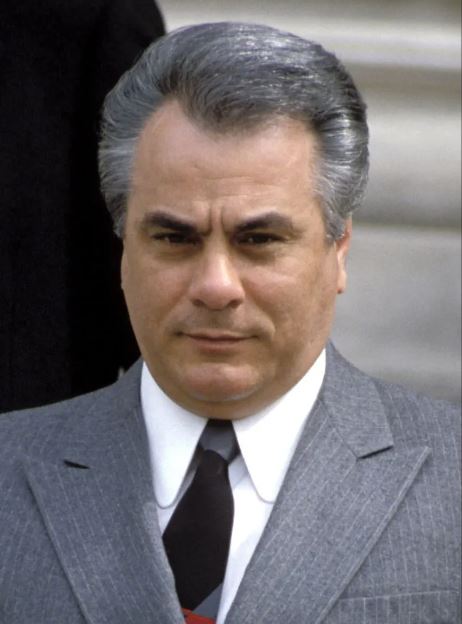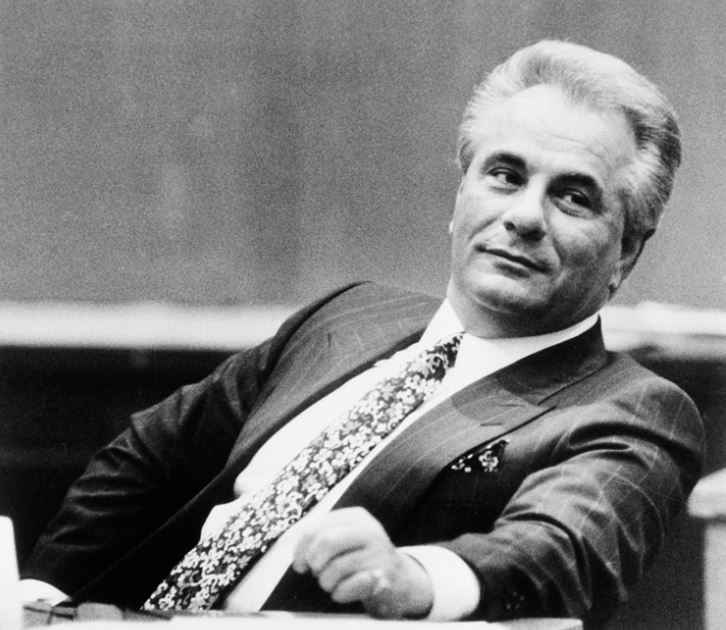The name John Gotti strikes fear and fascination in equal measure, the notorious “Teflon Don” whose grip on the Gambino crime family seemed unshakable for years. His trials, punctuated by courtroom drama and mob intimidation, were not merely legal battles—they were a chilling symbol of how organized crime had become entrenched in the very fabric of American society. The story of Gotti’s rise to power and eventual downfall paints a haunting portrait of a man who appeared untouchable, even as his empire unraveled. This is the tale of the trials that ultimately brought down the kingpin of the Gambino family, revealing the dark underbelly of the Mafia and the relentless pursuit of justice that would eventually shatter the myth of Gotti’s invincibility.

The Rise of a Ruthless Kingpin
John Gotti didn’t start as a godfather, but his ascent through the violent ranks of the Gambino family was nothing short of meteoric. In the 1980s, Gotti swiftly rose to become the boss of one of New York City’s most feared Mafia families, known for his ruthless leadership and a charisma that made him a legend in both criminal circles and the media. His reign was marked by brazen murders, illegal gambling, and the orchestration of shady deals that seemed to slip through the cracks of the justice system.
What made Gotti truly notorious, however, was his ability to avoid conviction. He became infamous for beating the system, earning the moniker “Teflon Don” as charges seemed to slide off him like water off a duck’s back. Despite the Mafia’s deeply ingrained culture of fear and loyalty, Gotti’s ability to manipulate the courts and intimidate witnesses made him a figure of fascination—and terror.
The 1986 RICO Trial: The First Battle
In 1986, the U.S. government set its sights on Gotti, bringing forth a RICO (Racketeer Influenced and Corrupt Organizations) case that sought to dismantle his criminal empire. The charges were severe: murder, loansharking, illegal gambling, obstruction of justice, and conspiracy. But Gotti’s defense team, led by the brash and combative Bruce Cutler, managed to derail the case, using every trick in the book. Jury tampering, witness intimidation, and a legal circus that would later become legendary allowed Gotti to slip through the fingers of law enforcement once again.
The case, fraught with holes and tainted by corruption, resulted in an acquittal. Gotti walked free, his myth cemented. He was not just a mob boss—he was a master manipulator, capable of turning the legal system into a joke. The streets buzzed with rumors of his influence, and Gotti’s reputation as the untouchable godfather only grew stronger. But this victory would be fleeting. Gotti’s reign would soon be threatened by a new breed of law enforcement agents determined to bring him to justice—by any means necessary.
The 1987 Assault Trial: Another Victory for the Teflon Don
As the years passed, Gotti’s hold on the Gambino family grew stronger, but so did the efforts to take him down. In 1987, he faced charges for the assault of a union official. Once again, Gotti was acquitted, and his dominance was undisturbed. His ability to manipulate the system, combined with his reputation for violence and his community connections, allowed him to escape conviction once more. With each trial, the legend of the “Dapper Don” grew larger.
Yet, even as he basked in the glory of his legal victories, the walls were slowly closing in. The days of impunity were numbered, and the relentless pursuit of Gotti by law enforcement would soon reach its peak. The government would need more than just a legal strategy—it would need a weapon capable of shattering the code of silence that protected men like Gotti. And in 1992, that weapon came in the form of Salvatore “Sammy the Bull” Gravano.

The Turning Point: The 1992 Trial and the Betrayal of Sammy the Bull
In 1992, Gotti’s world would finally come crashing down. Federal prosecutors, led by the tenacious John Gleeson, launched a multi-pronged assault on Gotti’s criminal empire. For years, the government had struggled to infiltrate the Mafia’s impenetrable code of silence. But with Gravano’s shocking decision to flip, everything changed.
Gravano, Gotti’s trusted underboss and confidant, agreed to testify against him in exchange for a reduced sentence. This betrayal would be the catalyst that finally exposed the true depths of Gotti’s crimes. Gravano’s testimony, along with wiretapped conversations that revealed Gotti’s direct involvement in murders and criminal enterprises, painted a damning picture of the man who had long been considered untouchable.
The trial, held in the Brooklyn federal courthouse, became a media circus. The courtroom was filled with reporters, spectators, and heavy police presence as the prosecution presented its case. They had the tapes. They had the testimony. And now, they had the man who had once been Gotti’s closest ally, ready to tear down the façade of invincibility.
The Conviction: Gotti’s Fall from Grace
April 2, 1992, marked the day the Teflon Don finally met his fate. After just 13 hours of deliberation, the jury found John Gotti guilty on all counts. The charges ranged from murder to conspiracy, loansharking, and tax evasion. Gotti was sentenced to life in prison without the possibility of parole, a devastating blow to the once-mighty boss of the Gambino family. The days of his power, both in the underworld and in the courtrooms, were over.
For Gotti, the conviction was the end of an era. His reign as the king of the Gambino family had lasted for years, but it was brought down by the very system he had long evaded. It was a victory for law enforcement, a reminder that even the most powerful and ruthless criminals could eventually be brought to justice. But it was also a bitter reminder of the Mafia’s deep roots in American society, and the lengths to which it would go to protect its own.
The Legacy of the Gotti Trials: A New Era in the War Against the Mafia
The legacy of the John Gotti trials reverberates through the halls of law enforcement agencies to this day. The conviction was not just a victory for the government—it was a turning point in the war against organized crime. The case demonstrated the power of federal prosecution strategies, the effectiveness of cooperating witnesses, and the use of sophisticated surveillance techniques. Gotti’s downfall signaled the beginning of the end for the old guard of the Mafia, as law enforcement agencies dismantled the once-powerful crime families that had long ruled the streets of New York.
But Gotti’s trial was more than just a legal victory. It was a reflection of the changing face of organized crime in America. The old ways of doing business—bribery, fear, and violence—were no longer enough to keep the Mafia safe from the long arm of the law. The government’s success in bringing down the Teflon Don laid the groundwork for future prosecutions and sent a clear message to those who thought they were above the law: no one is untouchable.
Conclusion: The Teflon Don’s Lasting Impact
The trials of John Gotti remain a landmark in American legal history. They exposed the rot at the heart of organized crime and highlighted the tenacity and dedication of law enforcement in their pursuit of justice. Gotti’s fall from grace shattered the myth of the untouchable mob boss, and his conviction served as a warning to others who sought to follow in his footsteps.
As Gotti spent his final days in solitary confinement, his legacy lived on—not just in the criminal world, but in the fight against organized crime itself. The Teflon Don was no longer a symbol of invincibility. Instead, he had become a cautionary tale, a reminder that even the most powerful men can fall—and that justice, no matter how elusive, will always find a way.
A Creation of C.F. Marciano – The Boss Behind the Pen


